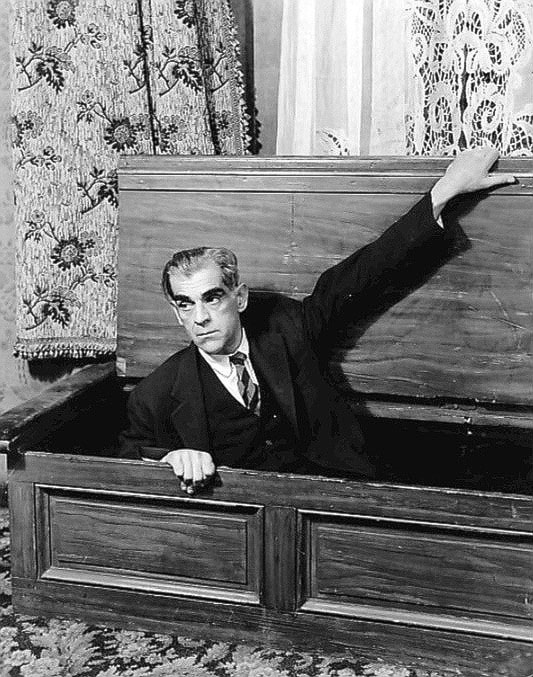Rehearsals for Arsenic and Old Lace are continuing at a rapid rate, with actors trying to get their lines learned. A constant piece of instruction from director Mavourneen Varcoe-Ryan is “Faster, faster!” in regards to the dialogue, which has to come with the rapid-fire patter of a machine-gun.
The play was first performed in August 1941, and is set in what was then the present day. This allowed playwright Joseph Kesselring to insert several references to real-life people, places, and events that a contemporary audience would have immediately got, but which can be a bit baffling to audiences 75 years later.
This is apparent in the opening minute, when Aunt Abby Brewster laments the “imitation flour” that people are having to use. America’s active participation in World War II was still four months away, and the country was not yet undergoing rationing; but Americans were being urged to conserve food in order to send supplies to Britain. Flour was one of many foodstuffs that were produced in “imitation” versions in order to cope with a scarcity of the real item.
Walter Winchell, the popular New York gossip columnist, gets a mention, as does actress Judith Anderson, when Mortimer Brewster urges his aunts to get out of the black mourning clothes they’re wearing, saying “You look like Judith Anderson!” A year before Arsenic and Old Lace was first performed, Anderson—one of the greatest classical actors of the 20th century—had made a memorable Hollywood debut as the sinister housekeeper Mrs. Danvers (who dresses only in black, in mourning for her dead employer) in Alfred Hitchcock’s film version of Rebecca.
Mortimer, a theatre critic, also mentions Burns Mantle when trying to find a replacement to cover a play for him. He suggests a possible candidate, then says “He might turn out to be another Burns Mantle!” Mantle was considered the dean of New York theatre critics at the time, and Mortimer appears to be worried that his replacement might be of similar calibre, and cost him his job.
One of the play’s running jokes is the fact that one of Mortimer’s brothers, Teddy, thinks he’s Teddy Roosevelt, the 26th President of the United States. Although Roosevelt died in 1919, he was a larger-than-life figure who was much remembered and admired, even years after his death (he is one of the four presidents whose likeness is carved at Mt. Rushmore).
Various references to Roosevelt’s life and work are made throughout the play, many to do with his close association with the promotion and building of the Panama Canal (and the toll that yellow fever took on the workers who dug the canal); his successor as president, William Howard Taft; and his passion for big game hunting, especially in Africa.
The Spanish–American War of 1898 also gives Teddy the running gag, throughout the play, of taking the stairs up to his bedroom at a run with a cry of “Charge!” Martha Brewster explains to a bewildered guest that to Teddy, the top of the stairs is the “blockhouse”, and “the stairs are always San Juan Hill.” The Spanish blockhouses atop San Juan Hill were part of the decisive battle of the Spanish–American War, and were charged—and taken—by the 1st United States Volunteer Cavalry (popularly known as the Rough Riders), who were commanded by Roosevelt, and who led the charge.
Another running joke throughout the play is the fact that the third Brewster brother, Jonathan, resembles horror movie star Boris Karloff after a botched attempt at plastic surgery. Jonathan’s resemblance to Karloff provokes shocked comments and horrified responses from those who see him, driving him into a near-murderous rage.
What would have made these exchanges even more funny to the original New York audience was the fact that in the stage version, Jonathan was played by none other than Boris Karloff (who, as I recounted last week, got his acting start with a travelling theatre company in Kamloops in 1911). Alas, Karloff was unavailable for the 1944 film version of the movie, as he was still starring in the play on Broadway; in the movie, the part was played by Canadian actor Raymond Massey.
Arsenic and Old Lace, presented by the Winding Rivers Arts & Performance Society, is at the Ashcroft HUB for five performances starting on November 12.
